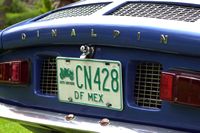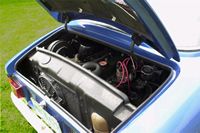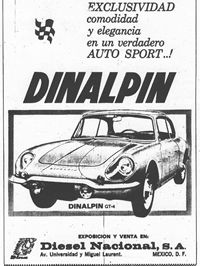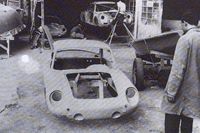| |
Alpine were made in France, Willys Interlagos in Brazil, and Dinalpin
in Mexico. Yuriria and Francisco Miranda (dinalpingt4@hotmail.com),
sympathetic mexican Alpine enthusiasts present us this last rare car.
 
We bought this car in october 1998 and on its first ride, although
working fine, was taken directly to the garage where it was checked
thoroughly, as it was kept in storage for more than two years.
It was built in 1971 and was sold as a 1972 model by Renault de Mexico.
It has a 1300 cc Sierra type engine with a Weber 32 DIR downdraught
twin barrel carburettor.
A little bit of history about this unique car :
After the commercial failure of the Chappe Brothers with the Alpine
2+2, a new coupe named GT4 was presented at the 1962 Paris Salon.
 
This car took the front of the coupe 2+2, but showed a more harmonious
rear end than the old design that was very square. It was Jean Rédélé
himself who designed along with his team of designers, the rear of the
2+2, therefore inheriting his aesthetic taste. He managed to integrate
his retouches to the ones of the Chappe Brothers. Apart from this renovation,
a deeper change took place related to the distance between axles, which
grew 10 centimetres compared to the 2+2, reaching 227 centimetres. The
GT4 was also known as the A110L, because of its longer distance between
axles and it was only available with the engine of the Renault R8 with
5 main bearing camshaft, which meant it was always of the A110 type.
 
Its chassis was made by Chappe and it was hold by bolts to the body
like the 2+2, which by the way, it was still on catalogue, but only
available with the 3 main bearing camshaft, base of the A108.
Like the preferred method of working by the Chappe Brothers, the first
car, the one on display in the Salon of 1962, was plated, so it was
used as counter moulding.
Stylistically the GT4 would not know any evolution, except
for those minimum details of equipment. However you can point to the
rhomboidal shape of Renault underneath the bumper, before 1967.
 
During the production year of 1969, it saw the disappearance of the
Cabriolet and GT4, whose production from some time before was almost
symbolic. It is known that some 112 GT4 were built between 1963 and
1965, which lead us to believe that production decreased with time and
the total production exceeded slightly 200 vehicles. The factory installed
in Mexico in 1964, built some GT4, along with Berlinettes and Cabriolets
until 1967, date of its closing
The mechanics changed lightly as the design itself. As mentioned earlier,
only exists as one A110, with the 5 main bearing camshaft. It was equipped
with a 956 cc engine for the 1963 and 64 models; the 1108 cc '70' with
66 horsepower in 1964; then in 1965, the version '85' (1108 cc, 85 HP)
and '100' (1108 cc, 95 HP) and for 1966 we could see the 1296 cc (1300S)
and the 1255 cc (R8 Gordini) for 1967. For the last year of production
only the 1108 '70' and the 1255 cc Gordini subsisted.
The GT4 will disappear from production during 1969.
Ref. : Alpine Label Blue - Christian Descombes - Ed. Presse Audiovisuel
- 1991
In the Paris Salon of 1962, the coupe 2+2 was presented with a new
design, even though it kept the former price tag. It was called from
then onwards, Coupe GT4 because of its 4 seating space.
Alpine Coupe GT4 :
- 4 seats, 2 doors
- 4.05 meters long
- 1.27 meters high
- 1.5 meters wide
- 2.27 meters distance between axles
- 600 Kg weight
- Fuel tank 32 litres
- Front suspension: independent, wishbone, rubber elements, coil,
springs, anti-roll bar, telescopic dampers
- Rear suspension: independent, swinging semi-axles, trailing radius
arms, coil springs, 4 telescopic dampers
- Mechanically equip derived from the Renault R8 and Floride "S"
- 5 main bearing camshaft and disc brakes in the 4 wheels
- Top speed from 155 to 175 KM/Hr, depending on the equipment installed.
Not only Berlinettes were built in Mexico but also the Coupe GT4 under
the Dinalpin trademark. We know little of this factory and the production
quantities obtained. One thing is for sure and is that the Mexican Alpine
still rides in the streets of Mexico and even nowadays the Berlinettes
participate in races and rallies in that country. How long did manufacturing
of the Mexican Alpine last ?
Ref. : Alpine, Tous les modèles, toutes les années - Pascal Dominique
- Ed. Massin
Registration :
You still see Dinalpin cars on the streets of Mexico and of course
on the race tracks and rallies throughout the country. And something
very important to mention here are that those cars not only participates
but also wins most races, beating even bigger engine vehicles! Mexican
production of the Dinalpin Berlinette stopped in 1974 and the factory
kept selling vehicles up until 1976. The GT4 production was divided
in two parts : from 1965 to 1967 and resumed from 1970 to 1972.
 
Production numbers are being investigated by Dr. Alfredo Sevilla and
you may find the numbers elsewhere in his website www.dinalpin.com.
It integrates a registred page.
More technical precisions :
It seems not even a service/ parts manual was ever printed and not
many cars in general good shape survive over here either. The rear windshield
was changed from Plexiglas to security glass and a new front windshield
was fitted as the original was in bad shape full of scratches.
Jorge Escobedo, who also owns a GT4, made the Plexiglas's covers for
the headlamps, with many difficulties as he explained us, because of
the double curves it has, making the mould difficult to remove without
breaking the new part. The suspension, as mentioned earlier, was overhauled
and stiffer shock absorbers (6) were fitted, new bushings, rubber parts,
etc.
 
We found some engine overheating problems but bit-by-bit we have gradually
reduced the temperature. The theory of operation of the cooling system
is similar to the one used in the Renault R8, although the space provided
for the engine is much smaller than in the R8. We have succeeded to
keep the temperature in the 80's when driven in traffic, but the problem
is still there when hill climbing and/or at high speeds, as the temperature
gets to the 100's a flat spot is present, either from air in the fuel
lines or coil over-heating. We are trying and electric fan forcing air
to the radiator and it seems it is doing the job, although more tests
have to be performed.
Also, the fuel tank is located right between the rear seat, the engine
(behind the wall of fire) and below the milliner; and as the rear windshield
is a big one, the sun strikes directly and heats the fuel tank along
with the heat generated from the engine, causing the fuel to vaporize,
and when full, you could even see the petrol (gasoline) coming out of
the vented cap in a small jet. That was fixed adding a 1/2" fibreglass
sheet below the carpet of the milliner above the tank and between the
wall of fire as well. Isolating material was fixed to the engine cover
as well. Apart from temperature, these materials also helped to reduce
noise from the engine to the cabin, making a long ride more comfortable.
 
The paint job took a long time to complete, as the fibreglass body
needed additional treatment, so after a layer was painted it had to
be sanded, therefore a new layer of paint was needed. We have been driving
the car between all of the different stages, and some details that had
aroused had been taken care of, but we are still working on it.
The mechanical job had been done at Heckler's, by Jose Luis Guaguaro
with important and vital input from Alberto Pedroza supervising originality;
Additional mechanics and fine tuning was done by Tomas Marin and others
by Braulio Corona; Paint job by Octavio Sevilla; Parts and replacements
were mostly supplied by Sergio Nicolai. We sincerely appreciate all
of the valuable input of this and other friends (a long list to mention)
whose help has made us finish our very nice Dinalpin GT4.
If you wish to send any comments or if you have some information, please
feel free to contact us at dinalpingt4@hotmail.com
It will be appreciated.
Yuriria & Francisco Miranda
|
|












